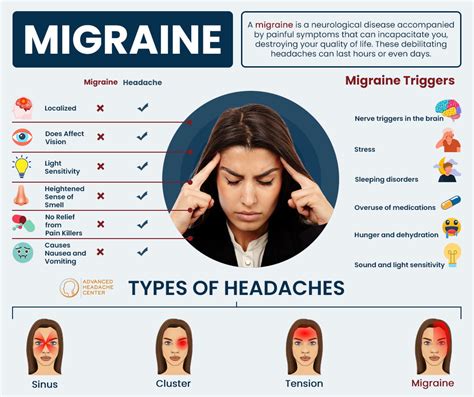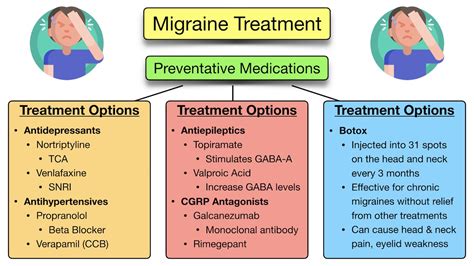Intro
Discover 5 surprising migraine facts, exploring triggers, symptoms, and treatments, to better understand migraine causes, prevention, and relief, alleviating headache pain.
Migraines are a type of neurological disorder that can cause severe and debilitating symptoms, affecting millions of people worldwide. Despite their prevalence, migraines are often misunderstood and underdiagnosed, leading to inadequate treatment and management. Understanding the complexities of migraines is crucial for developing effective prevention and treatment strategies. In this article, we will delve into the world of migraines, exploring the latest research and findings to provide a comprehensive overview of this condition. Whether you are a migraine sufferer or simply looking to learn more about this condition, this article aims to provide valuable insights and information to help you better understand and manage migraines.
Migraines are more than just a headache; they are a complex condition that can affect various aspects of a person's life, from their relationships and work to their overall well-being. The symptoms of migraines can be severe and debilitating, making it essential to seek medical attention if you experience frequent or severe headaches. By understanding the causes, symptoms, and treatment options available, individuals can take control of their migraines and improve their quality of life. In the following sections, we will explore the different aspects of migraines, including their causes, symptoms, diagnosis, treatment options, and management strategies.
Migraines are a significant public health concern, affecting people of all ages and backgrounds. According to the World Health Organization (WHO), migraines are one of the top 10 causes of disability worldwide, with an estimated 1 billion people suffering from this condition. In the United States alone, it is estimated that over 37 million people suffer from migraines, with women being three times more likely to experience migraines than men. Despite the prevalence of migraines, there is still much to be learned about this condition, and ongoing research is focused on developing new and effective treatments to manage migraines.
Migraine Causes and Triggers

Genetic Factors
Genetics play a significant role in the development of migraines, with many people having a family history of this condition. Research has identified several genetic variants that can increase the risk of developing migraines, including mutations in the genes responsible for serotonin and dopamine regulation. While genetic factors cannot be changed, understanding your genetic predisposition can help you take proactive steps to manage your migraines.Environmental Triggers
Environmental triggers can also contribute to the development of migraines, including stress, certain foods, and sensory stimuli. Common food triggers include chocolate, caffeine, and MSG, while sensory triggers can include bright lights, loud noises, and strong smells. Keeping a headache diary can help you identify your individual triggers and develop strategies to avoid them.Migraine Symptoms and Diagnosis

Headache Symptoms
The headache symptoms of migraines can be severe and debilitating, making it essential to seek medical attention if you experience frequent or severe headaches. The headache symptoms of migraines can include throbbing or pulsating pain, usually on one side of the head, and can be accompanied by nausea, vomiting, and sensitivity to light and sound.Aura Symptoms
In some cases, migraines can cause aura symptoms, such as visual disturbances, numbness, and tingling. Aura symptoms can occur before or during the headache phase of a migraine and can include a range of symptoms, such as zigzag patterns, blind spots, and numbness or tingling in the face or extremities.Migraine Treatment and Management

Lifestyle Changes
Making lifestyle changes can help reduce the frequency and severity of migraines, including maintaining a consistent sleep schedule, staying hydrated, and avoiding triggers. Regular exercise, stress management, and relaxation techniques, such as meditation and deep breathing, can also help reduce migraine symptoms.Medication
Medication can be effective in managing migraine symptoms, including pain relievers, triptans, and ergots. Pain relievers, such as ibuprofen and acetaminophen, can help alleviate headache symptoms, while triptans and ergots can help constrict blood vessels and reduce inflammation.Migraine Prevention and Self-Management

Keeping a Headache Diary
Keeping a headache diary can help you identify your individual triggers and symptoms, allowing you to develop effective prevention and management strategies. A headache diary can include information such as the date and time of your migraines, the severity of your symptoms, and any potential triggers.Stress Management
Stress management is essential for reducing migraine symptoms, including regular exercise, relaxation techniques, and lifestyle changes. Stress can exacerbate migraine symptoms, making it essential to develop effective stress management strategies, such as meditation, deep breathing, and yoga.Migraine and Mental Health

Anxiety and Depression
Anxiety and depression are common comorbidities with migraines, with many people experiencing symptoms of both conditions. Addressing mental health concerns is essential for managing migraines, including seeking professional help, practicing stress management techniques, and developing coping strategies.Cognitive-Behavioral Therapy
Cognitive-behavioral therapy (CBT) can be an effective treatment for migraines, including addressing mental health concerns and developing coping strategies. CBT can help individuals identify and challenge negative thought patterns, develop stress management techniques, and improve their overall quality of life.Migraine Research and Future Directions

Personalized Medicine
Personalized medicine is an emerging field in migraine research, involving the development of tailored treatments based on an individual's unique genetic profile and medical history. Personalized medicine can help improve treatment outcomes and reduce the risk of adverse effects.Artificial Intelligence and Machine Learning
Artificial intelligence and machine learning can be used to analyze large datasets and identify patterns and predictors of migraine attacks. This can help develop more effective prevention and treatment strategies, including predicting when a migraine attack is likely to occur.What are the most common migraine triggers?
+The most common migraine triggers include stress, certain foods, and sensory stimuli, such as bright lights or loud noises.
How can I prevent migraines?
+Preventing migraines requires a comprehensive approach, including lifestyle changes, medication, and self-management strategies, such as maintaining a consistent sleep schedule, staying hydrated, and avoiding triggers.
What are the best treatments for migraines?
+The best treatments for migraines include lifestyle changes, medication, and self-management strategies, such as pain relievers, triptans, and ergots, as well as alternative therapies, such as acupuncture and massage.
Can migraines be cured?
+While there is no cure for migraines, ongoing research is focused on developing new and effective treatments to manage the symptoms and reduce the frequency and severity of attacks.
How can I manage migraine symptoms?
+Managing migraine symptoms requires a comprehensive approach, including lifestyle changes, medication, and self-management strategies, such as keeping a headache diary, practicing stress management techniques, and developing coping strategies.
In conclusion, migraines are a complex and multifaceted condition that can have a significant impact on an individual's quality of life. By understanding the causes, symptoms, and treatment options available, individuals can take control of their migraines and improve their overall well-being. We encourage you to share your experiences and thoughts on migraines in the comments section below and to explore the many resources available for managing and preventing migraines. Together, we can work towards a better understanding of this condition and develop effective strategies for managing its symptoms.
